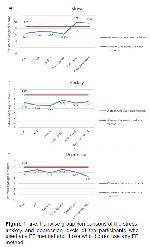In this study, it was aimed to determine the effects of family planning (FP) methods used by women in Turkey on their depression, anxiety and stress levels. In our study, it was determined that the participants who used any FP method had higher levels of education than those who did not use any FP method (p=0.050; Table
1). Previous studies have shown a positive relationship between education level and the status of FP use among women
22,23. A high educational level could provide advantages in contraceptive use in two ways. First, it allows women to obtain more accurate information about FP methods. Second, as their education processes are not interrupted, women may be more likely to postpone getting pregnant by using modern methods
24. A study conducted in Iran showed that 46.7% of women who used any FP method had university or higher degrees, and 37.6% of them had high school degrees, whereas 31.2% of women who did not use any FP method had university or higher degrees, and 22.2% of them had high school degrees
25. The results of our study were similar to those reported in other studies conducted in Muslim-majority countries and other countries.
In our study, it was determined that the participants who had a previous pregnancy and those who had given birth before had higher rates of FP method use (p=0.000; Table 1). However, there was no significant difference between the income levels and employment statuses of the participants who used any FP method and those who did not use any FP method, but still, the FP use rates of the working women were numerically higher than that of the women who were not working. Previous studies have also found that reaching ones ideal number of children or womens employment increases the rates of using FP methods among women 22,26. In a study carried out in Mali, where the ideal number of children was reported as 6, it was stated that those who had given birth four or more times were more likely to use modern contraceptives 23,25.
In our study, 79.4% of the participants were found to use a FP method, 59.5% used a modern method, and 22.9% used a traditional method (Table 2). Studies have shown that education, information, attitudes, approaches to gender-related issues, as well as cultural and religious beliefs, affect the use of FP methods and the type of the method used. This is why, in the international literature on this topic, the rates of FP use and types of FP methods have shown a high level of variation 23. For example, in a study in Mali, the rate of using modern FP methods was found as 17.1% 23. A study conducted in Nigeria reported that 43.9% of women used modern FP methods 27. In a study Kenya, in which most of the participants consisted of Protestants and Catholics, the rate of FP method use was determined as 34%. Especially in developing countries, gender roles imposed upon men and women in patriarchal societies lead men to play a more active role in deciding upon the use of FP methods and women to be pushed to the background. Studies performed in Turkey have reported the rates of using any FP method between 65.9% and 87.2% 26,28,29. According to the 2018 report of TNSA, 49% of women in Turkey use modern contraception methods, whereas 21% use traditional methods 29. Our study, in general, showed similarities to other studies conducted in Turkey. It is believed that differences may have originated from differences in the sociodemographic characteristics of women, the number of family members in their household and regional differences. The differences in our study from studies in the international literature may have occurred as a consequence of differences in ethnic structures, the developmental levels of countries and levels of access to FP methods.
In this study, it was observed that the stress levels of the participants who used the withdrawal method or the calendar method were significantly higher than those who did not use any FP method and those who used the combined hormonal contraception (CHC), IUD, tube ligation or condom method (p<0.001; Table 3). This result may have arisen because those who do not use reliable methods are more exposed to stress, and individuals who use reliable methods feel safer 30. Moreover, some participants who were not using any FP method might have not used such methods as they were thinking of getting pregnant. In our study, the anxiety levels of the participants who did not use any FP method were higher than those who used CHC, IUDs, tube ligation or condoms. According to the types of FP methods used among our participants, the depression levels of those who used a FP method were lower than those who did not use any method, but this difference was not statistically significant. There is no study in the literature that has determined the effects of the types of FP methods used by women on their depression, anxiety and stress levels together. In another study conducted in Turkey, it was seen that the anxiety levels of women who used the withdrawal method were higher in comparison to those who used condoms, oral contraceptives or IUDs 31.
In this study, it was found that the stress levels of the participants who were using traditional methods were higher than those who did were not using any FP method and those who were using modern FP methods (p<0.001; Table 4). Furthermore, it was discerned that the participants who did not use any FP method experienced higher levels of anxiety than those who used traditional or modern methods. A previous study demonstrated that women who used traditional FP methods used these methods as their spouses preferred them 32. Another study determined the self-esteem levels of women who used traditional FP methods to be low 33. In the same study, the withdrawal method, which was identified as the most frequently utilized method among traditional FP methods, affected the sex lives of women negatively 33. It was reported that women who used traditional methods had poor compatibility with their partners 34. It is considered that these factors may expose women to stress.
In this study, it was observed that the participants who used any of the hormonal contraceptive, IUD, condom and tube ligation methods had lower levels of stress and anxiety than those who did not use any FP method (Figure 1a-b). Women do not use FP methods or stop using these methods for various reasons. Some of such reasons may be listed as the prevention of their use of FP methods by their partner, women being kept under control even in their reproduction process due to patriarchal social structures, lack of trust in the protection capacity of some methods, fear of getting pregnant while using a contraception method, pain, infection, difficulty in usage, dizziness, irritability, stomachache and nausea, weight gain, thinking that such methods can create an imbalance in hormones, and wanting to have children 35-38. These factors could psychologically affect women in a negative way 39. Hence, these factors may explain the higher levels of stress in the participants of our study who did not use any FP method.
In this study, it was determined that the women who used traditional family planning methods and those who did not use any family planning method experienced higher levels of stress and anxiety than the women who used modern methods. Based on these results, one may argue that if midwives and nurses provide counseling for women and their partners regarding modern family planning methods, mental problems of women related to family planning can be prevented. In this way, before diseases occur, risk factors are prevented, contributing to the protection of health. Raising awareness about the use of family planning methods and gender equality in society may make it possible to solve misconceptions and negative attitudes about these methods.
Limitations of the Study
Because the number of participants was limited, and each participant had different individual characteristics, the results and findings of this study cannot be generalized to other populations or samples. Future studies could be carried out with larger samples and women who have different sociodemographic characteristics. The findings are largely limited to the individuals participating in the research and their responses to the scales.
Declarations
Funding: The authors declare that no funds, grants, or other support were received during the preparation of this manuscript.
Financial interests: All authors certify that they have no affiliations with or involvement in any organization or entity with any financial interest or non-financial interest in the subject matter or materials discussed in this manuscript.
Competing Interest: The authors have no relevant financial or non-financial interests to disclose







